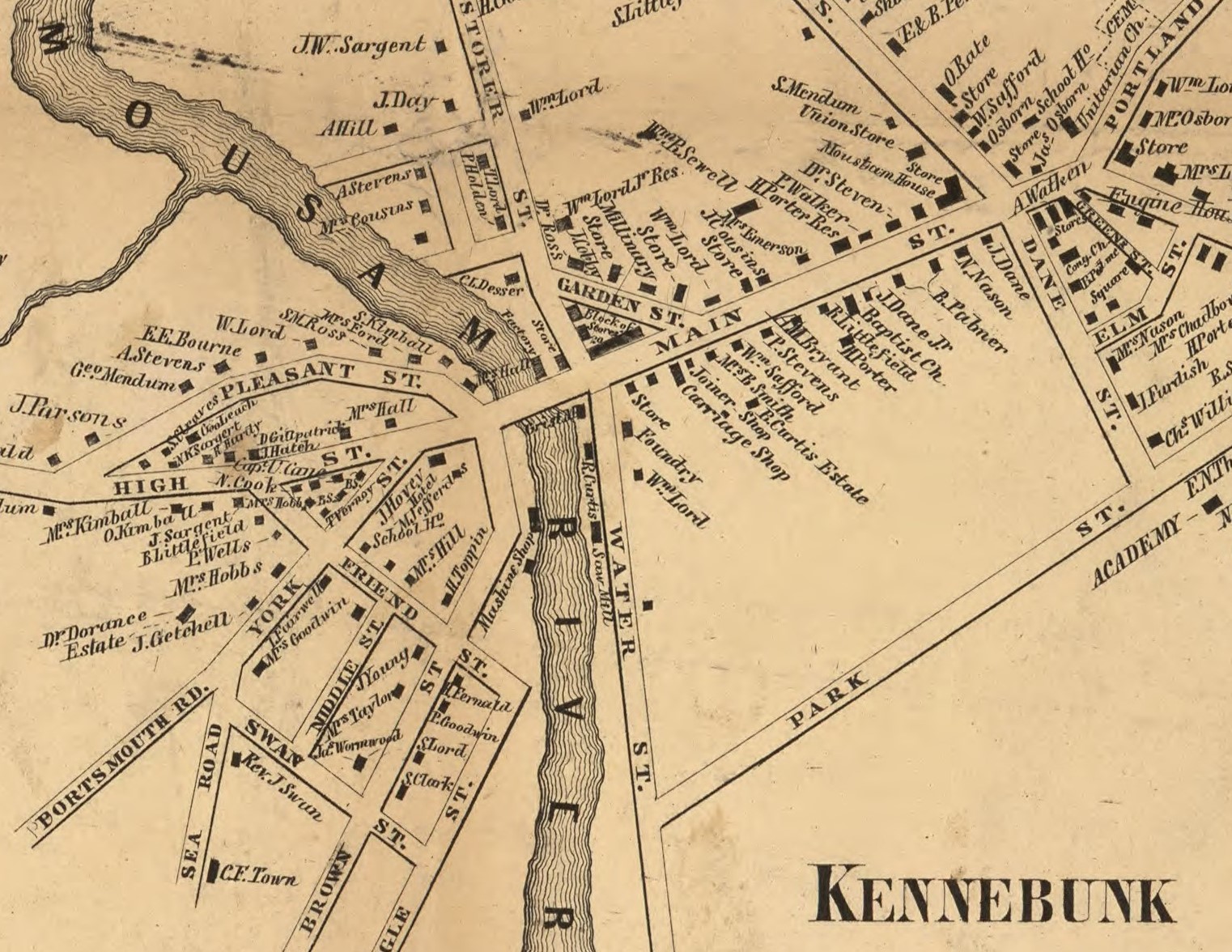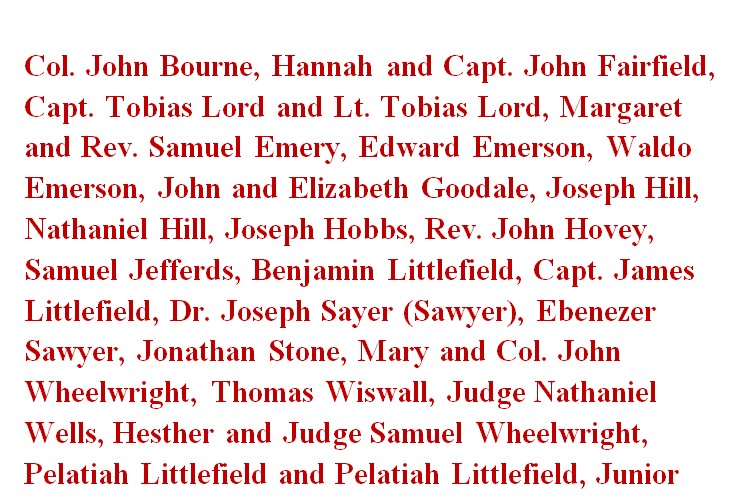Just History: Stories & Experiences
The Stories & Experiences section of the Just History Database includes articles that expand upon the people and events within the Database. It is intended to be a community-built research site to further study and amplify the stories of those who were historically marginalized.
While each article is held to the Brick Store Museum’s Principles of History Interpretation, and reviewed prior to publication, individual articles may contain hypotheses that do not represent the views of the Museum. You are encouraged to explore the Database and make your own conclusions. Questions? Email us at justhistory@brickstoremuseum.org.
Return to the Database here.
Highlights & Information

Historic Maps of the Local Area
The two most complete sets of historic maps of the area are from 1856 and 1872, when maps were created for all York County towns. The 1856 set, Map of York County Maine from Actual Survey, was published by J.L. Smith Co., based on the work of the surveyor, J. […]

Did You Know?
– That People of Color were enslaved by many of the area’s most prominent citizens? They included Col. John Bourne, Hannah and Capt. John Fairfield, Capt. Tobias Lord and Lt. Tobias Lord, Margaret and Rev. Samuel Emery, Edward Emerson, Waldo Emerson, John and Elizabeth Goodale, Joseph Hill, Nathaniel Hill, Joseph […]
Research Articles
The First Enslaved Person in Arundel
The First Enslaved Person in “Arundel” was paid for by the Town. “In August 1729, the town by their vote dismissed Mr. Eveleth from his relation to them as a Minister, and he ceased preaching. In the beginning of the next year Mr. Thomas Prentice was engaged as a preacher, received a regular call in June, and was ordained in November following. At this time a Church was duly organized.”[1] Prentice was “the first settled minister in town.”[2] This was the town of Arundel, what is now Kennebunkport. More specifically, it was in the settled area that is now Cape […]
The Indigenous Story of Southern Maine
We have included in the database as much information about Indigenous individuals as we’ve been able to locate, including entries for Ramanascho, Sasagohaway. and Wane Doney, along with those with more recent ties to our area, including Joseph Nicolar, Lucy Nicolar Poolah, and Leslie Ranco. Yet the stories of most of the Indigenous people who lived here were not recorded and have been lost to us. Scholarship by Dr. Emerson Baker of Salem State University suggests that the indigenous people that lived between the Kennebec River and Massachusetts Bay were called the Almouchiquois. Evidence from archaeology and ethnohistory points to […]
Sheppard Bourn – a Story of Impressment at Sea
Sheppard Bourn was the son of Salem and Peggy. His father Salem (DOB 1755) had been enslaved by John Bourne (1708-1788), the “ancestor of all the Bourne families in Wells and Kennebunk”[1] and a major shipbuilder. “A great many vessels of all sizes were built by him, on the Webhannet, Mousam and Kennebunk Rivers. He continued in the business more than fifty years. Most of his sons were educated to the same profession.”[2] Salem Bourne served in the Revolutionary War in 1778, and married Peg in 1784. Sheppard was born in Wells on May 2, 1787. He was married to […]
A Presidential Pardon
On March 20, 1830, the following statement came forth from the White House: “Whereas it has been represented to me that the American Brig Volant … belonging to Adam Stone and Asa Fairfield, citizens of the United States residing in Kennebunk, State of Maine, has been seized by the Customs House Officers of the United States, at New Orleans in Louisiana, and libeled as forfeited to the United States for a violation of the act of Congress prohibiting the importation of slaves … and whereas it has been made satisfactorily to appear that the said owners are entirely exempt from […]
A Negro Man Jeff, an “Heirloom” to Several Generations of the Wells Family
Thomas Wells (1672-1737) and John Wells (1670-1748) were brothers, and the sons of John Wells. They were prominent citizens of the town of Wells. They both enslaved “servants” and passed this “property” to their heirs. The story of Jeff is particularly notable as it involved several generations of the Wells family. Thomas Wells “was chosen Deacon of the church at Wells, March 3, 1718.”1 Later that year, on October 21st, he purchased “a negro boy named Jeffy” from Nathan Hale for £55. 2 In his 1737 will, Thomas stated “I give & bequeath unto my Dearly beloved Wife Lydia Wells […]
Some Prominent Men of Kennebunk
Here are some examples of how slavery was not uncommon amongst the prominent businessmen of early Wells (which included Kennebunk until 1820). “In 1728, a grant was made, by the ‘proprietors,’ of the old mill lot to Joseph Hill and John Storer, which was laid out and the bounds renewed, “as formerly of three hundred acres of land on the northeast side of the Mousam River, adjoining the river and falls, and one acre on the west side, with all the privileges of the fall and river, which was formerly granted unto Henry Sayward, of York.”……..Hill and Storer built a […]
Quock Walker, the Massachusetts Constitution and the Abolition of Slavery in Maine
In 1780, when the Massachusetts Constitution went into effect, slavery was legal in the Commonwealth of Massachusetts, of which Maine was a part until 1820. During the years 1781 to 1783, in three related cases known today as “the Quock Walker case,” the Massachusetts Supreme Judicial Court applied the principle of judicial review to abolish slavery. In doing so, the Court held that laws and customs that sanctioned slavery were incompatible with the new state constitution. In the words of then-Supreme Judicial Court Chief Justice William Cushing: “[S]lavery is in my judgment as effectively abolished as it can be by […]
Historic Maps of the Local Area
The two most complete sets of historic maps of the area are from 1856 and 1872, when maps were created for all York County towns. The 1856 set, Map of York County Maine from Actual Survey, was published by J.L. Smith Co., based on the work of the surveyor, J. Chase. The 1872 set were published as the Atlas of York County, Maine published by Sanford, Everts & Co. of Philadelphia. The maps depicting Wells in 1658 and 1715/16 were drawn by Peter Moody for My Name is Wells by Hope Moody Shelley. This was a history of Wells that […]
Did You Know?
– That People of Color were enslaved by many of the area’s most prominent citizens? They included Col. John Bourne, Hannah and Capt. John Fairfield, Capt. Tobias Lord and Lt. Tobias Lord, Margaret and Rev. Samuel Emery, Edward Emerson, Waldo Emerson, John and Elizabeth Goodale, Joseph Hill, Nathaniel Hill, Joseph Hobbs,Rev. John Hovey, Samuel Jefferds, Benjamin Littlefield, Capt. James Littlefield, Dr. Joseph Sayer (Sawyer), Ebenezer Sawyer, Jonathan Stone, Mary and Col. John Wheelwright, Thomas Wiswall, Judge Nathaniel Wells, Hesther and Judge Samuel Wheelwright, Peletiah Littlefield and Peletiah Littlefield, Jr. – That the first enslaved person in Arundel (today’s Kennebunkport) was […]
